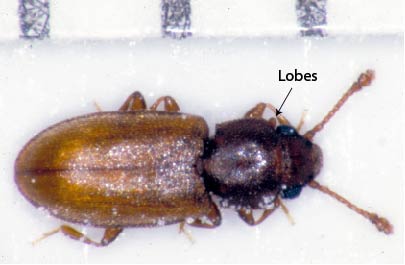Stored Product Pests
FOREIGN GRAIN BEETLE Ahasverus advena (Waltl)
Linda J. Mason, Extension Entomologist
If you want to view as pdf, click here
DESCRIPTION
Adults are brown and about 2 mm (1 /12 in.) long. Antennae are slender except for the last three segments, which are distinctly enlarged. They are about the size of a sawtoothed grain beetle, to which they are closely related, but somewhat broader. They are easily distinguished by the single conspicuous toothlike lobes at the front corners of the prothorax. Adults are capable of flight.
Young larvae are white, and mature larvae are grayish with the last few segments darkened. They are similar in shape and size to larvae of the sawtoothed grain beetle and have no forked process at the tip of the abdomen.
Foreign grain beetle. (Photo Credit: John Obermeyer)
BIOLOGY AND BEHAVIOR
Eggs, which are laid singly or in clusters of two or three, hatch in 4-5 days. Larval development is completed in 11-19 days. When ready to pupate, the larva constructs a chamber of food particles cemented together. It then attaches itself to the substrate with a brownish substance from the anal aperture. Pupation occurs after a prepupal period of 1-2 days, and adults emerge 3-5 days later. Thus, the development cycle is about 30 days under favorable conditions. Females begin laying eggs 3-4 days after emergence. Most oviposition bouts last 20-30 days and alternate with periods during which no eggs are laid (5-23 days). Daily oviposition rates are 1-4 eggs but can be as high as 8-12 eggs. Peak oviposition occurs 15 days post emergence and 90-105 days post emergence. The insects do not breed when the relative humidity is below 65% in most foods; in some foods this is true below 80%. Mated males and females have an average lifespan of 159 and 208 days, respectively. Unmated beetles live considerably longer – males 275 days – females 301 days.
Humidity is very important to the survival of this beetle. Low humidities are unsuitable for both larval development and oviposition. Larval development times increase with decreasing humidity so that the mean period from egg to adult increases from 19 days at 92% Rh to 24 days at 66% Rh. Humidity has little effect on the egg, prepupal or pupal stages. Most larvae have 4 instars, however, as humidity decreases, the proportion with 5 instars increase. Oviposition is also effected by humidity; at 75% Rh 1.5 eggs/day are laid while at 58% Rh the rate diminishes to 0.1 egg/day
FOOD
This species occurs on a wide variety of food stuffs, including grains, cereal products, oil seeds and their products, dried fruit, and spices. It is a scavenger that feeds on molds, dead insects, and damaged foods. On cereal grains, the embryo is a suitable food material. However, when found in large numbers they are probably feeding on molds present in the food. Foreign grain beetles have been reared on pure cultures of certain molds commonly found in grains and are considered a good indicator of damp storage conditions.
READ AND FOLLOW ALL LABEL INSTRUCTIONS. THIS INCLUDES DIRECTIONS FOR USE, PRECAUTIONARY STATEMENTS (HAZARDS TO HUMANS, DOMESTIC ANIMALS, AND ENDANGERED SPECIES), ENVIRONMENTAL HAZARDS, RATES OF APPLICATION, NUMBER OF APPLICATIONS, REENTRY INTERVALS, HARVEST RESTRICTIONS, STORAGE AND DISPOSAL, AND ANY SPECIFIC WARNINGS AND/OR PRECAUTIONS FOR SAFE HANDLING OF THE PESTICIDE.
November 2018

It is the policy of the Purdue University Cooperative Extension Service that all persons have equal opportunity and access to its educational programs, services, activities, and facilities without regard to race, religion, color, sex, age, national origin or ancestry, marital status, parental status, sexual orientation, disability or status as a veteran. Purdue University is an Affirmative Action institution. This material may be available in alternative formats.
This work is supported in part by Extension Implementation Grant 2017-70006-27140/ IND011460G4-1013877 from the USDA National Institute of Food and Agriculture.
1-888-EXT-INFO
www.extension.purdue.edu
Order or download materials from www.the-education-store.com



